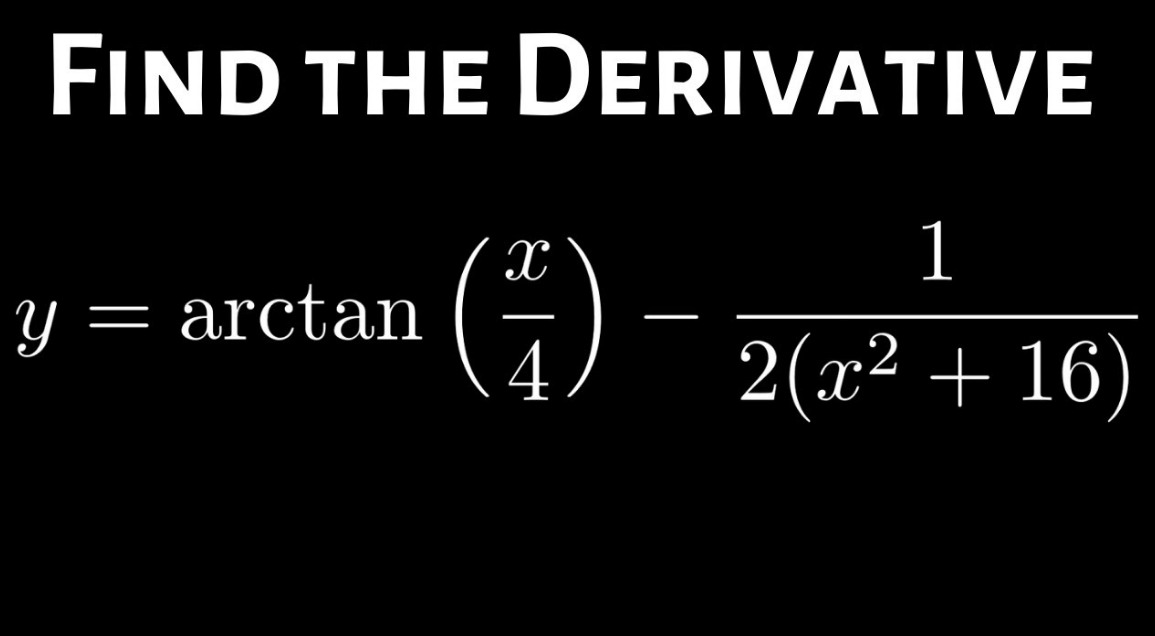Derivative of Arctan: Before going to see what is the derivative of arctan, let us see some facts about arctan. Arctan (or) tan-1 is the inverse function of the tangent function. i.e., If y = tan-1x then tan y = x. Also, we know that if f and f-1 are inverse functions of each other then f(f-1(x)) = f-1(f(x)) = x. From this, tan(arctan x) = arctan(tan x) = x in the respective domains. We use these facts to find the derivative of arctan x.
Let us see the formula of derivative of arctan along with proof and a few solved examples.

Table of Contents
What Is Derivative of Arctan?
The derivative of arctan x is represented by d/dx(arctan x) (or) d/dx(tan-1x) (or) (arctan x)’ (or) (tan-1x)’. Its value is 1/(1+x2). We are going to prove it in two methods in the upcoming sections. The two methods are
- Using the chain rule
- Using the first principle
Derivative of Arctan x Formula
The derivative of the arctangent function is,
- d/dx(arctan x) = 1/(1+x2) (OR)
- d/dx(tan-1x) = 1/(1+x2)
We are going to prove this formula now in the next sections.
Derivative of Arctan Proof by Chain Rule
We find the derivative of arctan using the chain rule. For this, assume that y = arctan x. Taking tan on both sides,
tan y = tan (arctan x)
By the definition of inverse function, tan (arctan x) = x. So the above equation becomes,
tan y = x … (1)
Differentiating both sides with respect to x,
d/dx (tan y) = d/dx(x)
We have d/dx (tan x) = sec2x. Also, by chain rule,
sec2y · dy/dx = 1
dy/dx = 1/sec2y
Using one of the trigonometric identities, sec2y = 1 + tan2y.
dy/dx = 1/(1 + tan2y)
dy/dx = 1/(1 + x2) (from (1))
Substituting y = arctan x back here,
d/dx (arctan x) = 1/(1 + x2)
Hence proved.
Derivative of Arctan Proof by First Principle
The derivative of a function f(x) by the first principle is given by the limit, f'(x) = limₕ→₀ [f(x + h) – f(x)] / h. To find the derivative of arctan x, assume that f(x) = arctan x. Then f(x + h) = arctan (x + h). Substituting these values in the above limit,
f'(x) = limₕ→₀ [arctan (x + h) – arctan x] / h
By inverse trigonometric formulas, We have arctan x – arctan y = arctan [(x – y)/(1 + xy)]. Apply this, we get
f'(x) = limₕ→₀ [arctan[(x + h – x)/(1 + (x + h) x)] ] / h
= limₕ→₀ (1/h) [arctan [ h / (1 + x2 + hx) ] ]
We have arctan x = x – x3/3 + x5/5 – … Using this, we get
f'(x) = limₕ→₀ (1/h) [ h / (1 + x2 + hx) – [h / (1 + x2 + hx)]3 / 3 + [h / (1 + x2 + hx)]5 / 5 – ….]
= limₕ→₀ (1/h) [ h / (1 + x2 + hx) – [h3 / [3(1 + x2 + hx)3] + [h5 / [5(1 + x2 + hx)5]- ….]
Distributing (1/h),
f'(x) = limₕ→₀ [ 1 / (1 + x2 + hx) – [h2 / [3(1 + x2 + hx)3] + [h4 / [5(1 + x2 + hx)5]- ….]
Applying the limit h→0,
f'(x) = 1 / (1 + x2 + 0) – 0 + 0 – …
f'(x) = 1/(1 + x2)
Hence proved.
Topics Related to Derivative of Arctan:
Here are some topics that are related to the derivative of arctan x.
FAQs
The derivative of arctan x is 1/(1+x2). i.e., d/dx(arctan x) = 1/(1+x2). This also can be written as d/dx(tan-1x) = 1/(1+x2).
To derive the derivative of arctan, assume that y = arctan x then tan y = x. Differentiating both sides with respect to y, then sec2y = dx/dy. Taking reciprocal on both sides, dy/dx = 1/(sec2y) = 1/(1+tan2y) = 1/(1+x2).
We have the derivative of arctan x to be 1/(1 + x2). By using this and chain rule, the d/dx(arctan x/2) = 1/(1+(x/2)2) d/dx (x/2) = 1/(1 + (x2/4)) · (1/2) = [4/(4 + x2)] · (1/2) = 2/(4 + x2).
We know that the derivative of arctan x to be 1/(1 + x2). By using this formula and chain rule, the d/dx(arctan √x) = 1/(1+(√x)2) d/dx (√x) = 1/(1 + x) · (1/2√x) = 1/(2√x(1+x)).
No, the derivative of arctan is NOT tan. The derivative of arctan x is 1/(1 + x2).
The derivative of tan x is sec2x whereas the derivative of arctan x is 1/(1+x2).
The derivative of arctan x to be 1/(1 + x2). By using this and chain rule, the d/dx(arctan x/a) = 1/(1+(x/a)2) d/dx (x/a) = 1/(1 + (x2/a2)) · (1/a) = [a2/(a2 + x2)] · (1/a) = a/(a2 + x2).

